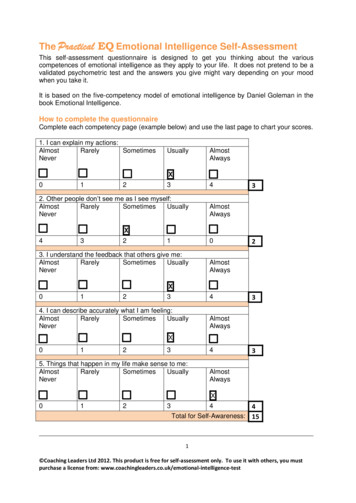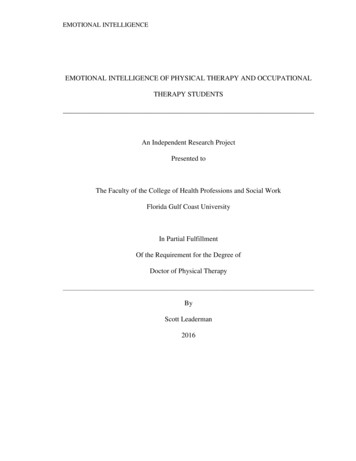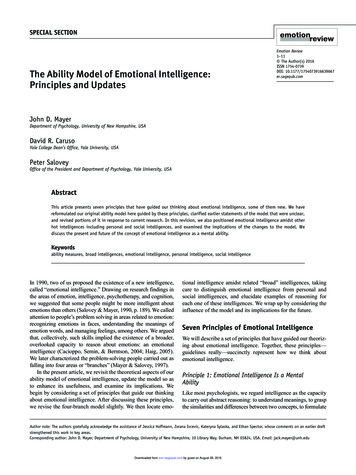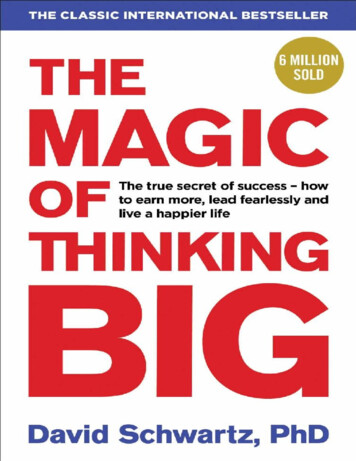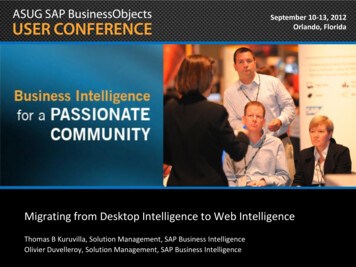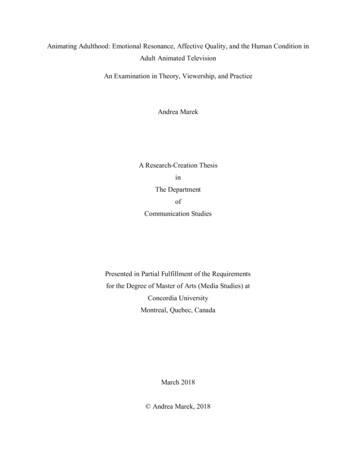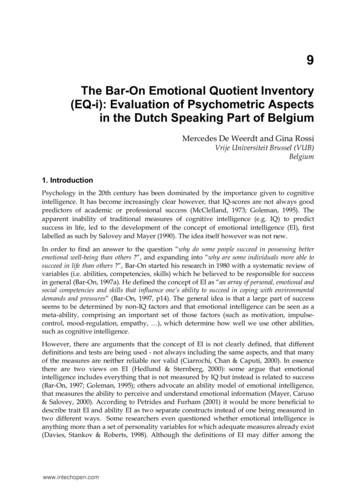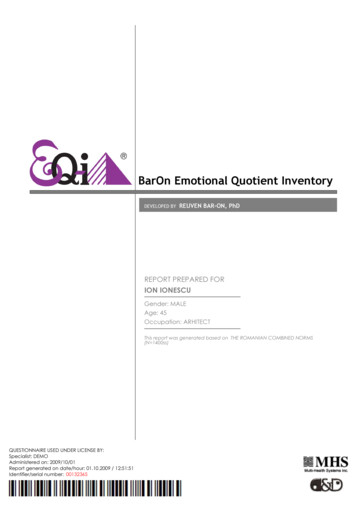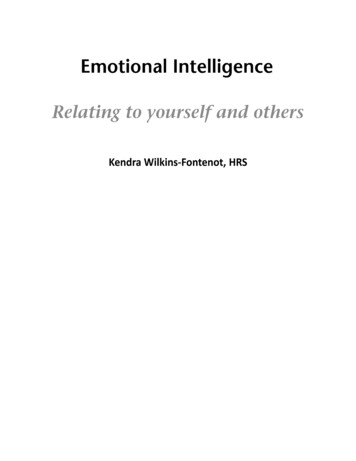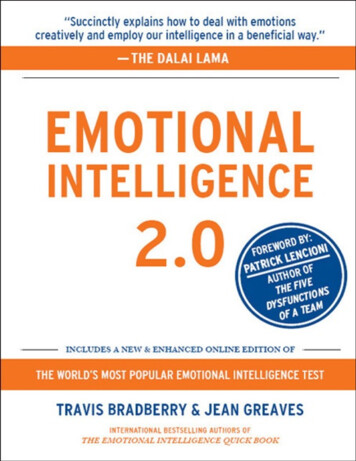
Transcription
PRAISE FOREmotional Intelligence 2.0“All sentient beings possess awareness, but among them human beings possessgreat intelligence. Subject to a constant stream of positive and negative thoughtsand emotions, what distinguishes us as human beings is that we are capable ofpositive change. Emotional Intelligence 2.0 succinctly explains how to deal withemotions creatively and employ our intelligence in a beneficial way.”—the Dalai Lama “A fast read with compelling anecdotes and good context inwhich to understand and improve your score.”—Newsweek “Surveys of 500,000 people on the role of emotions in daily lifehave enabled the authors to hone EQ assessment to a 28-question online surveythat can be completed in seven minutes.”—The Washington Post “Read worthy strategies for improving emotionalintelligence skills make this our how-to book of the week. It’s nice to know thataverage IQ doesn’t limit a person to average performance. And who can resist anonline quiz with instant feedback?”—Newsday “This book gives abundant, practical findings and insights withemphasis on how to develop EQ. Research shows convincingly that EQ is moreimportant than IQ in almost every role and many times more important inleadership roles.”—Stephen R. Covey, author of the perennial bestseller,The 7 Habits of Highly Effective People“Emotional intelligence is an extremely important skill to have for personal andprofessional success. This book is excellent and the learning included in the freeonline test is cutting-edge. I strongly recommend it.”—Ken Blanchard, bestselling business book author ofall time; coauthor The One Minute Manager “My clients tend to be very successful and incredibly busy. This book deliversvaluable insights without wasting time! My coaches and I have done powerfulwork aided by this book and the emotional intelligence test that comes with it. Afantastic combination for learning the skills that are critical to high jobperformance.”—Marshall Goldsmith, bestselling author ofWhat Got You Here Won’t Get You There, andpremier executive educator as ranked byThe Wall Street Journal, Forbes, The Harvard Business Review,and Fast Company“At last a book that gives how to’s rather than just what to’s. We need no moreconvincing that emotional intelligence is at the core of life success. What we
need are practical ways of improving it. Bradberry and Greaves’ brilliant newbook is a godsend. It will change your life.”—Joseph Grenny, New York Times bestselling coauthor of,Crucial Conversations“This book is filled with wisdom, inspiration, and practical advice, rooted ingroundbreaking research. The authors’ positive strategies are immenselypowerful and will change the way you look at your life, your work, and theworld.”—Captain D. Michael Abrashoff,author of the bestseller It’s Your Ship“If you’re wondering why your career is stalled or plateaued—or if you simplywant to get on the fast track to the next level—this book is a must-read.Emotional intelligence is the sine qua non of success at work and this book givesyou a quick-start to developing critical skills and behaviors to complement yourtechnical expertise.”—Lois P. Frankel, Ph.D., New York Times bestselling author,Nice Girls Don’t Get the Corner Office“This book is a wake-up call for anyone who wants to dramatically improvetheir work life and strengthen their relationships. Drs. Bradberry and Greavesoffer powerful research, practical strategies, and fascinating stories that willtransform the way we think about ourselves and how we interact with those wecare about the most.”—Jim Loehr, New York Times bestselling author,The Power of Full Engagement“I distributed the book to my entire team. We found it very helpful in ourdealings with each other and our internal customers. With all the new buzzwordsover the past few years, the heart and soul of a company’s culture is how theysupport and promote emotional intelligence. Those with foresight see thatemotional intelligence will separate the good companies from the great ones.This book is a wonderful tool for a grass-roots approach. If your desire is to be atruly resonant leader that people will trust and follow, this is an opportunity thatcannot only change your professional career, but also your personalrelationships.”—Regina Sacha, vice president, human resources,FedEx Custom Critical“In the fast lane of business life today, people spend more time on computerkeyboards, BlackBerries and conference calls than they do in face-to-facecommunication. We’re expected to piece together broken conversations, crypticvoicemails, and abbreviated text messages to figure out how to proceed. In this
increasingly complex web, emotional intelligence is more important than everbefore. This book is filled with invaluable insights and information that no onecan afford to ignore.”—Rajeev Peshawaria, executive director,Goldman Sachs International“Drs. Bradberry and Greaves have created a gem that is powerful and easy toread. This book provides a captivating look at the things that matter most in life.Succeeding in Hollywood is as tough as any business, and emotional intelligenceskills are essential. I highly recommend this book.”—Matt Olmstead, executive producer, Prison Break and NYPD Blue“This is a wonderful, practical, helpful book full of tools and techniques you canuse to get along better with all the people in your life.”—Brian Tracy, bestselling author, Eat That Frog“Drs. Bradberry and Greaves have succeeded in creating a practical summary ofemotional intelligence. Without being simplistic, this book is accessible tomanagers and employees who need a quick yet sophisticated understanding ofthe topic. This book and TalentSmart e-learning are important components ofNokia’s management and employee development programs.”—Jennifer Tsoulos, M.S., human resources, Nokia Mobile Phones “Whip outyour pen and get ready to take copious notes. This wonderful gem of a book ischock-a-block full of invaluable insights and incredibly useful suggestions—backed by strong scientific evidence. Word for word this is the most preciousbook I’ve read in a long time. I will give it to all my friends and clients as theone ‘must read’ for the season.”—Jim Belasco, New York Times bestselling coauthor,Flight of the Buffalo“This book is a great resource for those of us charged with providing emergencyservices to the public. Through the simple and effective steps outlined in thebook, I was able to learn and subsequently put into practice the emotionalintelligence skills necessary to better relate to my customers during crisissituations. This book is a tool most supervisors should find useful in facilitatingteamwork and promoting esprit de corps.”—Dominick Arena, fire captain, City of Escondido,California, Fire Department“Emotional intelligence is a critical determinant of a physician’s ultimate successor failure. Drs. Bradberry and Greaves have hit the bull’ s-eye with this timelyresearch-based resource. I teach emotional intelligence in our facultydevelopment leadership program, and I also mentor medical students. I canenvision how this book can be woven into the medical school curriculum.”
—Dixie Fisher, Ph.D., assistant professor of clinical,Keck School of Medicine, USC“Success in my business is quantifiable and backing highly effective CEOs inour portfolio companies has been the key. There is no doubt in my mind that thisbook hits the nail on the head. Emotional intelligence in an individualdetermines the outcome more than any other factor, and is the one leastunderstood. This book is a ‘must read’ for managers to gain insight and create aplan to improve their effectiveness as well as the success of the organization.”—Rick Hoskins, managing director, Genstar Capital, LLC
EMOTIONALINTELLIGENCE2.0INCLUDES A NEW & ENHANCED ONLINE EDITION OFTHE WORLD’S MOST POPULAR EMOTIONAL INTELLIGENCETESTTRAVIS BRADBERRY & JEAN GREAVESINTERNATIONAL BESTSELLING AUTHORS OFTHE EMOTIONAL INTELLIGENCE QUICK BOOK
11526 Sorrento Valley RoadSan Diego, CA 92121For information regarding special discounts for bulk purchases, contactTalentSmart at:888-818-SMART (toll free, US & Canada callers) or 858-509-0582Visit us on the web at www.TalentSmart.comCopyright 2009 by TalentSmart Copyright 2009 by Travis Bradberry, Ph.D., and Jean Greaves, Ph.D.All rights reserved, including the right of reproduction in whole or in part in anyform.ISBN: 978-0-9743206-2-5First Printing: 2009TalentSmart , Emotional Intelligence Appraisal , Emotional Intelligence 2.0,Emotional Intelligence Quick Book, Goal Tracking System, and the flying manlogo are trademarks of TalentSmart , Inc., San Diego, CA.The Emotional Intelligence Appraisal items, feedback report, and e-learningare protected by copyright of TalentSmart , Inc., 2001-2009. All rights reserved.Illustrations by CruxCreative.com
To the loyal TalentSmart certified trainersand all who’ve attended their sessions.Your passion is the breath of life for this book.CONTRIBUTORSThe following individuals madesignificant contributions to this book.Sue DeLazaro, M.S.Melissa Monday, Ph.D.Jean Riley, Ph.D. ABDLac D. Su, Ph.D. ABDNick Tasler, M.S.Eric Thomas, MBA, M.S.Lindsey Zan, M.S.
Your purchase of Emotional Intelligence 2.0 includes online access to theEmotional Intelligence Appraisal For Kindle users: Your unique passcode for the Emotional IntelligenceAppraisal is distributed by Amazon and has been sent to the email address youhave registered with Kindle.For all other eBook users: Please email ebook@talentsmart.com and provide acopy of your purchase receipt. You will receive a reply back with a uniquepasscode to the Emotional Intelligence Appraisal .Once you receive your passcode, follow the steps below to take your test: 1. Go towww.TalentSmart.com/test2. Click on the “TAKE THE TEST” button,3. Type your passcode and click on the “Submit” button to begin your test.Anytime you want to revisit your test results, return to TalentSmart.com/test,click on the “VIEW MY REPORT” button, and log in with your passcode.
CONTENTSForeword by Patrick Lencioni1. The Journey2. The Big Picture3. What Emotional Intelligence Looks Like:Understanding the Four Skills4. Digging In: An Action Plan to Increase Your EQ5. Self-Awareness Strategies6. Self-Management Strategies7. Social Awareness Strategies8. Relationship Management StrategiesEpilogue—Just the Facts: A Look at the Latest Discoveries in EmotionalIntelligenceDiscussion Questions for Reading GroupsNotesLearn More
FOREWORDot education. Not experience. Not knowledge or intellectual horsepower.None of these serve as an adequate predictor as to why one person succeedsand another doesn’t. There is something else going on that society doesn’t seemto account for.We see examples of this every day in our workplaces, our homes, ourchurches, our schools and our neighborhoods. We observe supposedly brilliantand well-educated people struggle, while others with fewer obvious skills orattributes flourish. And we ask ourselves why?The answer almost always has to do with this concept called emotionalintelligence. And while it is harder to identify and measure than IQ orexperience, and certainly difficult to capture on a resume, it’s power cannot bedenied.And by now, it’s not exactly a secret. People have been talking aboutemotional intelligence for a while, but somehow they haven’t been able toharness its power. After all, as a society we continue to focus most of our selfimprovement energy in the pursuit of knowledge, experience, intelligence andeducation. This would be fine if we could honestly say we had a fullunderstanding of our emotions, not to mention the emotions of others, and anunderstanding of how our emotions influence our lives so fundamentally everyday.I think the reason for this gap between the popularity of emotionalintelligence as a concept and its application in society is twofold. First, peoplejust don’t understand it. They often mistake emotional intelligence for a form ofcharisma or gregariousness. Second, they don’t see it as something that can beimproved. Either you have it or you don’t.And that’s why this is such a helpful book. By understanding what emotionalintelligence really is and how we can manage it in our lives, we can begin toleverage all of that intelligence, education and experience we’ve been storing upfor all these years.So, whether you’ve been wondering about emotional intelligence for years orknow nothing about it, this book can drastically change the way you think aboutsuccess. You might want to read it twice.Patrick Lencioniauthor of The Five Dysfunctions of a Team;president of the Table GroupN
1THE JOURNEYhe warm California sun greeted Butch Connor as he stepped out of his truckand onto the sands of Salmon Creek Beach. It was the first day of a longholiday weekend, and a perfect morning to grab his board and head out for asurf. Most of the other local surfers had the same idea that morning, and after 30minutes or so, Butch decided to leave the crowd behind. He penetrated thewater’s surface with long, deep strokes that propelled him away from the packand over to a stretch of beach where he could catch a few waves away from thecrowd.Once Butch had paddled a good 40 yards away from the other surfers, he satup on his board and bobbed up and down in the rolling swells while he waitedfor a wave that caught his fancy. A beautiful teal wave began to crest as itapproached the shoreline, and as Butch lay down on his board to catch the wave,a loud splash behind him stole his attention. Butch glanced over his rightshoulder and froze in horror at the sight of a 14-inch, gray dorsal fin cuttingthrough the water toward him. Butch’s muscles locked up, and he lay there in apanic, gasping for air. He became hyper-focused on his surroundings; he couldhear his heart pounding as he watched the sun glistening on the fin’s moistsurface.The approaching wave stood tall to reveal Butch’s worst nightmare in theshimmering, translucent surface—a massive great white shark that stretched 14feet from nose to tail. Paralyzed by the fear coursing through his veins, Butch letthe wave roll past, and with it a speedy ride to the safety of the shoreline. It wasjust the shark and him now; it swam in a semi-circle and approached him headon. The shark drifted in slowly along his left side, and he was too transfixed bythe proximity of the massive fish to notice his left leg dangling perilously off hissurfboard in the frigid saltwater. It’s as big around as my Volkswagen, Butchthought as the dorsal fin approached. He felt the sudden urge to reach out andtouch the shark. It’s going to kill me anyway. Why shouldn’t I touch it?TThe approaching wave stood tall to reveal Butch’s worst nightmare in theshimmering, translucent surface—a massive great white shark thatstretched 14 feet from nose to tail.The shark didn’t give him a chance. The shark, with a massive chomp of itsjaws, thrust its head upward from underneath Butch’s leg. Butch’s leg stayed ontop of the shark’s rising, boulder-sized head and out of its cavernous mouth, andhe fell off the opposite side of his surfboard into the murky water. Butchsplashing into the water sent the shark into a spastic frenzy. The shark waved its
head about maniacally while snapping its jaws open and shut. The great whitestruck nothing; it blasted water in all directions as it thrashed about. The irony offloating alongside a 3,000-pound killing machine without so much as a scratchwas not lost on Butch. Neither was the grave reality that this apex predator wasunlikely to miss again. Thoughts of escape and survival flooded Butch’s mind asquickly and completely as terror had in the moments prior.The shark stopped snapping and swam around Butch in tight circles. Insteadof climbing back on his surfboard, Butch floated on his belly with his armsdraped over the board. He rotated the surfboard as the shark circled, using thesurfboard as a makeshift barrier between himself and the man-eater. Butch’s fearmorphed into anger as he waited for the beast to strike. The shark came at himagain, and Butch decided it was time to put up a fight. He aimed the sharp,pointed nose of his surfboard at the shark as it approached. When it raised itshead out of the water to bite, Butch jammed the nose of the board into theshark’s slotted gills. This blow sent the shark into another bout of nervousthrashing. Butch climbed atop his board and yelled, “Shark!” at the pack ofsurfers down the beach. Butch’s warning and the sight of the turbulent cauldronof whitewater around him sent the surfers racing for dry land.Butch also paddled toward safety, but the shark stopped him dead in histracks after just a few strokes. It surfaced in his path to the shoreline, and thenbegan circling him once more. Butch came to the dire conclusion that his evasivetactics were merely delaying the inevitable, and a paralyzing fear took hold ofhim yet again. Butch lay there trembling on his surfboard while the sharkcircled. He mustered the will to keep the tip of his board pointed in the shark’sdirection, but he was too terror-stricken to get back in the water and use hisboard as a barrier.Butch’s thoughts raced between terror and sadness. He wondered what histhree children were going to do without him and how long his girlfriend wouldtake to move on with her life. He wanted to live. He wanted to escape thismonster, and he needed to calm down if that was ever going to happen. Butchconvinced himself that the shark could sense his fear like a rabid dog; he decidedthat he must get hold of himself because it was his fear that was motivating theshark to strike. To Butch’s surprise, his body listened. The trembling subsided,and the blood returned to his arms and legs. He felt strong. He was ready topaddle. And paddle Butch did—straight for the shoreline. A healthy rip currentensured that his journey to shore was a nerve-rattling five minutes of paddlinglike mad with the sense that the shark was somewhere behind him and couldstrike at any moment. When Butch made it to the beach, an awestruck group ofsurfers and other beachgoers were waiting for him. The surfers thanked him
profusely for the warning and patted him on the back. For Butch Connor,standing on dry land had never felt so good.WHEN REASON AND FEELING COLLIDEButch and the great white weren’t fighting the only battle in the water thatmorning. Deep inside Butch’s brain, his reason struggled for control of hisbehavior against an onslaught of intense emotions. The bulk of the time, hisfeelings won out, which was mostly to his detriment (paralyzing fear) but attimes a benefit (the anger-fueled jab of his surfboard). With great effort, Butchwas able to calm himself down, and—realizing the shark wasn’t going away—make the risky paddle for shore that saved his life. Though most of us will neverhave to tussle with a great white shark, our brains battle it out like Butch’s everysingle day.The daily challenge of dealing effectively with emotions is critical to thehuman condition because our brains are hard-wired to give emotions the upperhand. Here’s how it works: everything you see, smell, hear, taste and touchtravels through your body in the form of electric signals. These signals pass fromcell to cell until they reach their ultimate destination, your brain. They enter yourbrain at the base near the spinal cord, but must travel to your frontal lobe (behindyour forehead) before reaching the place where rational, logical thinking takesplace. The trouble is, they pass through your limbic system along the way—theplace where emotions are produced. This journey ensures you experience thingsemotionally before your reason can kick into gear.The rational area of your brain (the front of your brain) can’t stop theemotion “felt” by your limbic system, but the two areas do influence each otherand maintain constant communication. The communication between youremotional and rational “brains” is the physical source of emotional intelligence.The physical pathway for emotional intelligence starts in the brain, at the spinalcord. Your primary senses enter here and must travel to the front of your brainbefore you can think rationally about your experience. But first they travel
through the limbic system, the place where emotions are experienced. Emotionalintelligence requires effective communication between the rational andemotional centers of the brain.When emotional intelligence was first discovered, it served as the missinglink in a peculiar finding: people with the highest levels of intelligence (IQ)outperform those with average IQs just 20 percent of the time, while people withaverage IQs outperform those with high IQs 70 percent of the time. Thisanomaly threw a massive wrench into what many people had always assumedwas the source of success—IQ. Scientists realized there must be another variablethat explained success above and beyond one’s IQ, and years of research andcountless studies pointed to emotional intelligence (EQ) as the critical factor.A Time magazine cover and hours of television coverage introduced millionsto EQ, and once people were exposed to it, they wanted to know more. Theywanted to know how EQ worked and who had it. Most importantly, peoplewanted to know if they had it. Books emerged to scratch this itch, including ourown, The Emotional Intelligence Quick Book. Released in 2004, the Quick Bookwas unique because each copy contained a passcode that let the reader go onlineand take the world’s most popular EQ test, the Emotional IntelligenceAppraisal . The book satisfied readers’ curiosity by teaching the ins and outs ofEQ and (thanks to the test) providing a new self-perspective that wasn’tavailable anywhere else.people with the highest levels of intelligence (IQ) outperform those withaverage IQs just 20% of the time, while people with average IQsoutperform those with high IQs 70% of the time.The Emotional Intelligence Quick Book hit home—it was an instant bestseller that has been translated into 23 languages and is now available in morethan 150 countries. But times have changed. The emotional intelligence field ison the steep incline of a new wave of understanding—how people can improvetheir EQ and make lasting gains that have a profoundly positive impact upontheir lives. Just as knowing your EQ score was reserved for the privileged fewbefore the publication of The Emotional Intelligence Quick Book, learning howto increase your EQ is something that happens only in isolated circles. Ourcompany trains hundreds of people each week to increase their EQ, but even atthis pace it would take 3,840 years to hit every adult currently residing in theU.S.! We realize that we’ve unwittingly been holding important informationback. We believe everyone should have the opportunity to increase his or herEQ, and have created this book to make it possible.YOUR JOURNEY
Emotional Intelligence 2.0 has one purpose—increasing your EQ. These pageswill take you far beyond knowing what EQ is and how you score. You’lldiscover time-tested strategies that you can begin using today to take your EQ tonew heights. As you transform yourself and bring new skills into your life,you’ll reap all of the benefits that this incredible human ability has to offer.The 66 strategies in this book are the result of many years of careful testingwith people just like you. These strategies provide the specifics of what you needto say, do, and think to increase your EQ. To glean everything they have to offer,you need to know where to focus your attention. The first major step in yourjourney to a higher EQ is to go online and take the new edition of the EmotionalIntelligence Appraisal test. Taking the test now provides a baseline againstwhich you can gauge your improvement as you read on and learn. Measuringyour EQ takes your learning beyond a conceptual or motivational exercise—your score profile uncovers the EQ skills you need to improve the most, and itpinpoints the individual strategies from this book that will get you there. Thisfeature is new to 2.0, and it takes the guesswork out of choosing the strategiesthat will increase your EQ the most.The value of measuring your EQ now is akin to learning the waltz with anactual partner. If I tell you how the dance works, you are likely to learnsomething and may even get the urge to try it yourself. If, as I show you how todo a waltz, you practice each step with a partner, your chances of rememberingthem later on the dance floor go up exponentially. The EQ profile you receivefrom taking the Emotional Intelligence Appraisal is your dance partner indeveloping these skills. It will remind you where to step with every beat of themusic.Your online report includes a goal-tracking system that summarizes the skillsyou are working on and provides automatic reminders to help you stay focused.E-learning activities bring EQ to life via clips from Hollywood movies,television and real-world events. You will also learn how your scores compare toother people’s.In addition to receiving the most accurate scores possible, taking theEmotional Intelligence Appraisal now lets you see how much your EQ scoresincrease with time. You can take the test twice—once now and again afteryou’ve had enough time to practice and adopt the strategies from this book.After you complete the test a second time, your updated feedback report willdisplay your scores side by side and offer insights into how you’ve changed andwhat your next steps should be to keep your EQ working for you. The orangeinsert at the back of this book contains instructions for going online to access the
Emotional Intelligence Appraisal , as well as the unique passcode that you’llneed to access the test.Emotions can help you and they can hurt you, but you have no say in thematter until you understand them. We invite you to begin your journey now,because we know that emotional mastery and understanding can become realitiesfor you.
2THE BIG PICTUREefore you take a closer look at each of the four EQ skills in the next chapter,there are some important things you need to know about EQ as a whole.Over the last decade we’ve tested more than 500,000 people to explore the roleemotions play in daily living. We’ve learned how people see themselves versuswhat others see, and we’ve observed how various choices affect personal andprofessional success.Despite the growing focus on EQ, a global deficit in understanding andmanaging emotions remains. Only 36 percent of the people we tested are able toaccurately identify their emotions as they happen. This means that two thirds ofus are typically controlled by our emotions and are not yet skilled at spottingthem and using them to our benefit. Emotional awareness and understanding arenot taught in school. We enter the workforce knowing how to read, write, andreport on bodies of knowledge, but too often, we lack the skills to manage ouremotions in the heat of the challenging problems that we face. Good decisionsrequire far more than factual knowledge. They are made using self-knowledgeand emotional mastery when they’re needed most.Considering the range of emotions people express, it’s no wonder they canget the better of us. We have so many words to describe the feelings that surfacein life, yet all emotions are derivations of five core feelings: happiness, sadness,anger, fear, and shame. As you move through your daily routine—whetheryou’re working, spending time with family or friends, eating, exercising,relaxing, or even sleeping—you are subject to a constant stream of emotions. Itis so easy to forget that we have emotional reactions to almost everything thathappens in our lives, whether we notice them or not. The complexity of theseemotions is revealed in their varying forms of intensity.BOnly 36 percent of the people we tested are able to accurately identifytheir emotions as they happen.
ADAPTED FROM AND REPRODUCED BY PERMISSION FROM JULIAWESTTriggers and Emotional HijackingsWhile Butch Connor was being attacked by a great white shark, he experiencedseveral emotional hijackings—moments when his emotions controlled hisbehavior and he reacted without thinking. Typically, the more intense youremotions are, the greater the likelihood that they will dictate your actions.Matters of life or death—such as being attacked by a massive beast—are certainto induce a temporary emotional hijacking.In Butch’s case, emotional hijackings left him paralyzed by fear, but even inthe presence of a man-eater, Butch was able to use his thoughts to take backcontrol from his emotions. Butch reasoned with himself until the paralysissubsided and he was calm enough to complete the paddle to shore. Butch’sthoughts didn’t make his feelings of fear and terror disappear, but they did keephis emotions from hijacking his behavior.Since our brains are wired to make us emotional creatures, your first reactionto an event is always going to be an emotional one. You have no control overthis part of the process. You do control the thoughts that follow an emotion, andyou have a great deal of say in how you react to an emotion—as long as you areaware of it. Some experiences produce emotions that you are easily aware of;other times, emotions may seem nonexistent. When something generates aprolonged emotional reaction in you, it’s called a “trigger event.” Your reactionto your triggers is shaped by your personal history, which includes yourexperience with similar situations. As your EQ skills grow, you’ll learn to spotyour triggers and practice productive ways of responding that will become
habitual.Sizing Up the Whole PersonEmotional intelligence is your ability to recognize and understand emotions inyourself and others, and your ability to use this awareness to manage yourbehavior and relationships. Emotional intelligence is the “something” in each ofus that is a bit intangible. It affects how we manage behavior, navigate socialcomplexit
powerful and will change the way you look at your life, your work, and the world.” —Captain D. Michael Abrashoff, author of the bestseller It’s Your Ship “If you’re wondering why your career is stalled or plateaued—or if you simply want to get on the File Size: 1MB

